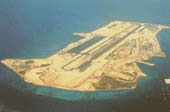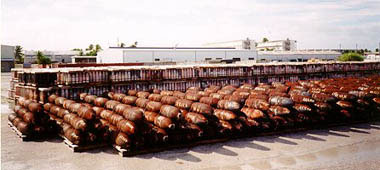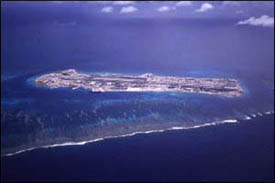Johnston Atoll Chemical Agent Disposal System (JACADS)
Note: EPA no longer updates this information, but it may be useful as a reference or resource.
| Johnston Atoll Chemical Agent Disposal System Quick Finder | ||||
Mission accomplished: JACADS safely destroys over 400,000 chemical weapons on Johnston Island
Decommissioning, dismantlement, and cleanup completed in 2003
On November 29, 2000, on isolated Johnston Island in the Central Pacific Ocean, the U.S. Army safely destroyed the last of over 400,000 obsolete chemical weapons collected from Okinawa and other U.S. military bases in the Pacific Basin and West Germany between 1971 and 1991. In September, 2002, EPA approved the Revised Closure Plan, which allowed the U.S. Army to begin dismantling and cleanup of the facility.
By November 2003, the U.S. Army completed cleanup and demolition of the incinerator buildings, and completed its final sampling for contaminants. EPA is expected to recieve the results of the sampling of areas surrounding the incinerator building. The results will be evaluated in a human health and ecological risk assessment. When the island is deemed safe for human and wildlife to inhabit, EPA will then certify the closure of the JACADS facility.
 The EPA's strict environmental oversight of the Army's Johnston Atoll Chemical Agent Disposal System (JACADS) since its construction began in 1985 helped the facility safely incinerate over 400 million lbs. of extremely toxic chemicals without a single injury to people or wildlife from chemical exposure. The incineration process destroyed the poisons at the molecular level, forever eliminating the threat that these deadly chemical weapons would be used.
The EPA's strict environmental oversight of the Army's Johnston Atoll Chemical Agent Disposal System (JACADS) since its construction began in 1985 helped the facility safely incinerate over 400 million lbs. of extremely toxic chemicals without a single injury to people or wildlife from chemical exposure. The incineration process destroyed the poisons at the molecular level, forever eliminating the threat that these deadly chemical weapons would be used.
The weapons had been stored in concrete igloos on the one-square mile island 800 miles southwest of Hawaii. The Johnston Island stockpile, amounting to about 6% of the total U.S. chemical arsenal in 1991, included some of the deadliest weapons of mass destruction ever devised: rockets, bombs, artillery shells, and mines filled with toxins so potent, in the case of nerve agent, that a single drop on the skin can kill a person.

JACADS was the first facility of its kind in the world. It was designed as a pilot for similar plants to be built on the U.S. mainland to destroy the entire U.S. chemical weapons stockpile, in accordance with an international treaty. The next such facility started operating in 2000 at an Army base in Tooele, Utah, and a third is now operating near Anniston, Alabama. JACADS may also provide a model for others to be built in the former Soviet Union.
In a "swords-to-ploughshares" move, the Army plans to transfer its property on the Pacific atoll to the U.S. Fish & Wildlife Service for inclusion in the existing Johnston Atoll National Wildlife Refuge, one of the most important bird nesting sites in the Pacific Ocean.

Over the 15 years of JACADS' construction and operation, EPA closely monitored the facility and regularly fine-tuned its hazardous waste disposal permit to prevent chemical releases. For the closure phase in 2000-2003, EPA approved changes in JACADS' permit, to improve air emissions monitoring.
- Public Notice of Change (PDF) (690 K--If you are not familiar with PDF, please read about PDF files.
 )
Images courtesy of the U.S. Army, the U.S. Fish and Wildlife Service,
)
Images courtesy of the U.S. Army, the U.S. Fish and Wildlife Service,
and the U.S. Army Corps of Engineers
![[logo] US EPA](../gif/logo_epaseal.gif)